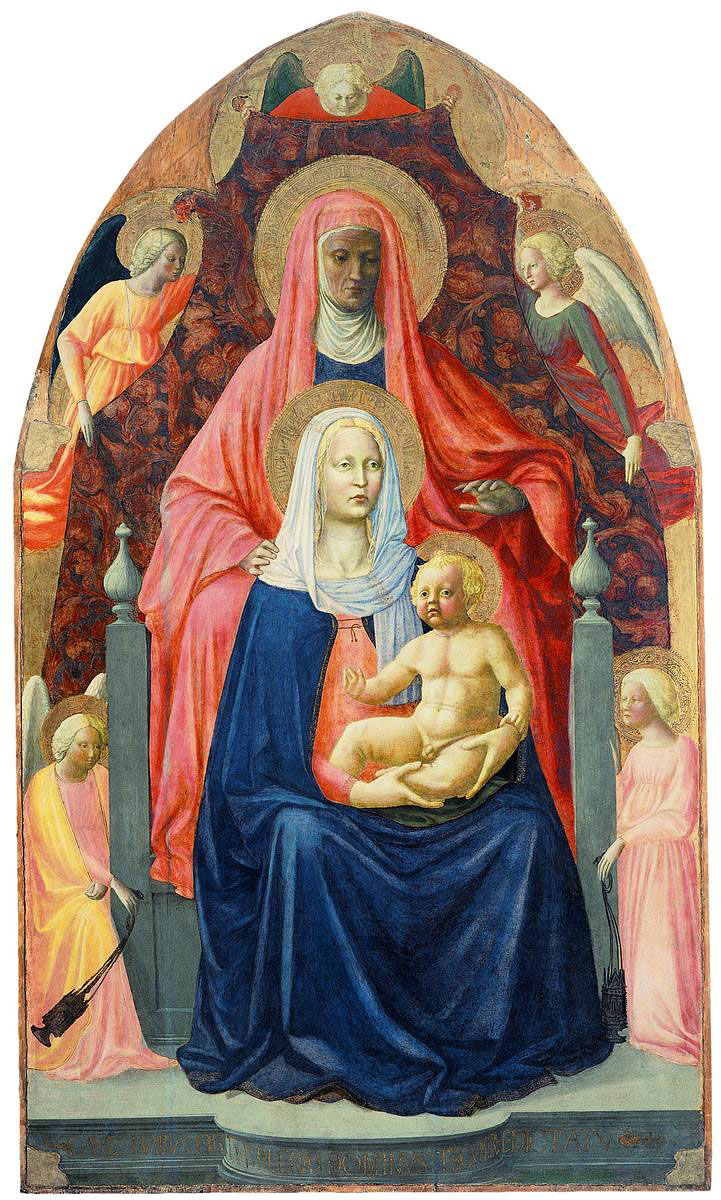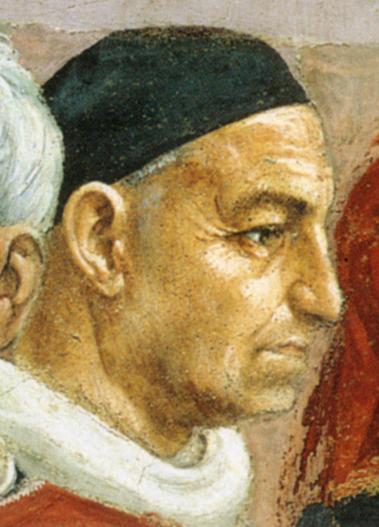|
Masolino Da Pannicale
Lordship of Perugia , death_date = , death_place = Florence, Republic of Florence , nationality = Italian , field = Painting, fresco , training = , movement = Italian Renaissance , works = frescoes in the Brancacci Chapel , patrons = Pipo of OzoraCardinal Branda Castiglione Tommaso di Cristoforo Fini ( – ), known by his nickname Masolino da Panicale (), was an Italian painter. His best known works are probably his collaborations with Masaccio: '' Madonna with Child and St. Anne'' (1424) and the frescoes in the Brancacci Chapel (1424–1428). Biography Masolino was possibly born in Panicale, present-day Umbria. He may have been an assistant to Ghiberti in Florence between 1403 and 1407. In 1423, he joined the Florentine guild ''Arte dei Medici e Speziali'' (Doctors and Apothecaries), which included painters as an independent branch. He may have been the first artist to create oil paintings in the 1420s, rather than Jan va ... [...More Info...] [...Related Items...] OR: [Wikipedia] [Google] [Baidu] |
Lives Of The Most Excellent Painters, Sculptors, And Architects
''The Lives of the Most Excellent Painters, Sculptors, and Architects'' () is a series of artist biographies written by 16th-century Italian painter and architect Giorgio Vasari, which is considered "perhaps the most famous, and even today the most-read work of the older literature of art",Max Marmor, ''Kunstliteratur'' translated by Ernst Gombrich, in Art Documentation Vol 11 # 1, 1992 "some of the 's most influential writing on art", and "the first important book on |
Guilds Of Florence
The guilds of Florence were secular corporations that controlled the arts and trades in Florence from the twelfth into the sixteenth century. These ''Arti'' included seven major guilds (collectively known as the ''Arti Maggiori''), five middle guilds (''Arti Mediane'') and nine minor guilds (''Arti Minori''). Their rigorous quality control and the political role in the commune that the ''Arti Maggiori'' assumed were formative influences in the history of Florence, which became one of the richest cities of late medieval Europe. The ''popolo minuto''—skilled workers including weavers, spinners, dyers, boatmen, laborers, peddlers and others—despite constituting a majority of the population, were barred from forming guilds. Formation of the ''Arti'' The guilds, medieval institutions that organized every aspect of a city's economic life, formed a social network that complemented and in part compensated for family ties, although in Florence the welfare side of the guilds' activit ... [...More Info...] [...Related Items...] OR: [Wikipedia] [Google] [Baidu] |
Naples
Naples ( ; ; ) is the Regions of Italy, regional capital of Campania and the third-largest city of Italy, after Rome and Milan, with a population of 908,082 within the city's administrative limits as of 2025, while its Metropolitan City of Naples, province-level municipality is the third most populous Metropolitan cities of Italy, metropolitan city in Italy with a population of 2,958,410 residents, and the List of urban areas in the European Union, eighth most populous in the European Union. Naples metropolitan area, Its metropolitan area stretches beyond the boundaries of the city wall for approximately . Naples also plays a key role in international diplomacy, since it is home to NATO's Allied Joint Force Command Naples and the Parliamentary Assembly of the Mediterranean. Founded by Greeks in the 1st millennium BC, first millennium BC, Naples is one of the oldest continuously inhabited urban areas in the world. In the eighth century BC, a colony known as Parthenope () was e ... [...More Info...] [...Related Items...] OR: [Wikipedia] [Google] [Baidu] |
Masolino Annunciation
Tommaso di Cristoforo Fini ( – ), known by his nickname Masolino da Panicale (), was an List of Italian painters, Italian painter. His best known works are probably his collaborations with Tommaso Masaccio, Masaccio: ''Virgin and Child with St. Anne (Masaccio), Madonna with Child and St. Anne'' (1424) and the frescoes in the Brancacci Chapel (1424–1428). Biography Masolino was possibly born in Panicale, present-day Umbria. He may have been an assistant to Lorenzo Ghiberti, Ghiberti in Florence between 1403 and 1407. In 1423, he joined the Guilds of Florence, Florentine guild ''Arte dei Medici e Speziali'' (Doctors and Apothecaries), which included painters as an independent branch. He may have been the first artist to create oil paintings in the 1420s, rather than Jan van Eyck in the 1430s, as was previously supposed. He spent many years traveling, including a trip to Hungary from September 1425 to July 1427 under the patronage of Pipo of Ozora, a mercenary captain. He was s ... [...More Info...] [...Related Items...] OR: [Wikipedia] [Google] [Baidu] |
Masolino 008
Lordship of Perugia , death_date = , death_place = Florence, Republic of Florence , nationality = Italian , field = Painting, fresco , training = , movement = Italian Renaissance , works = frescoes in the Brancacci Chapel , patrons = Pipo of OzoraCardinal Branda Castiglione Tommaso di Cristoforo Fini ( – ), known by his nickname Masolino da Panicale (), was an Italian painter. His best known works are probably his collaborations with Masaccio: '' Madonna with Child and St. Anne'' (1424) and the frescoes in the Brancacci Chapel (1424–1428). Biography Masolino was possibly born in Panicale, present-day Umbria. He may have been an assistant to Ghiberti in Florence between 1403 and 1407. In 1423, he joined the Florentine guild ''Arte dei Medici e Speziali'' (Doctors and Apothecaries), which included painters as an independent branch. He may have been the first artist to create oil paintings in the 1420s, rather than Jan va ... [...More Info...] [...Related Items...] OR: [Wikipedia] [Google] [Baidu] |
Vanishing Point
A vanishing point is a point (geometry), point on the projection plane, image plane of a graphical perspective, perspective rendering where the two-dimensional perspective projections of parallel (geometry), parallel lines in three-dimensional space appear to converge. When the set of parallel lines is perpendicular to a picture plane, the construction is known as one-point perspective, and their vanishing point corresponds to the station point, oculus, or "eye point", from which the image should be viewed for correct perspective geometry.Kirsti Andersen (2007) ''Geometry of an Art'', p. xxx, Springer, Traditional linear drawings use objects with one to three sets of parallels, defining one to three vanishing points. Italian Renaissance humanism, humanist polymath and architect Leon Battista Alberti first introduced the concept in his treatise on perspective in art, ''De pictura'', written in 1435. Straight Track geometry, railroad tracks are a familiar modern example. Vector ... [...More Info...] [...Related Items...] OR: [Wikipedia] [Google] [Baidu] |
Castiglione Olona
Castiglione Olona is a town and ''comune'' in the province of Varese, in Lombardy. As of 31 December 2015, it has a population of 7,753 inhabitants. The area of the town with the greatest tourist attractions is the historic center. The entrance to the historic center is through two gates in the ancient medieval walls, both on the street Via Roma: the Western Gate, for the people arriving from the medieval bridge over the Olona River, and the Eastern Gate, for those arriving from the modern part of the town. History The town of Castiglione Olona rose around the fifth century CE under the Roman Empire domain. Consequently, the Lombards entered and took possession of the village until the Castiglioni family became sole proprietor of the land around 1000 AC. The family engaged in many battles for the rule of the lands so they had walls built all around the village to protect themselves from enemies. Today only a small part of the walls near the fortress is visitable. In 1422, cardina ... [...More Info...] [...Related Items...] OR: [Wikipedia] [Google] [Baidu] |
Todi
Todi (; ''Tuder'' in antiquity) is a town and ''comune'' (municipality) of the province of Perugia (region of Umbria) in central Italy. It is perched on a tall two-crested hill overlooking the east bank of the river Tiber, commanding distant views in every direction. It was founded in antiquity by the Umbri, at the border with Etruria; the gens Ulpia of Roman emperor Trajan came from Todi. In the 1990s, Richard S. Levine, a professor of Architecture at the University of Kentucky, included Todi in academic design exercises aimed at conceiving hypothetical improvements to the city and presented its results in a conference titled "The Sustainable City of the Past and the Sustainable City of the Future". As a result, the Italian press incorrectly reported on Todi as ''the world's most livable city''. History According to the legend, said to have been recorded around 1330 BC by a mythological Quirinus Colonus, Todi was built by Hercules, who here killed Cacus, and gave the city the ... [...More Info...] [...Related Items...] OR: [Wikipedia] [Google] [Baidu] |
Basilica Of San Clemente
The Basilica of Saint Clement () is a Latin Catholic minor basilica dedicated to Pope Clement I located in Rome, Italy. Archaeologically speaking, the structure is a three-tiered complex of buildings: (1) the present basilica built just before the year 1100 during the height of the Middle Ages; (2) beneath the present basilica is a 4th-century basilica that had been converted out of the home of a Roman nobleman, part of which had in the 1st century briefly served as an early church, and the basement of which had in the 2nd century briefly served as a mithraeum; (3) the home of the Roman nobleman had been built on the foundations of republican era villa and warehouse that had been destroyed in the Great Fire of AD 64. History This ancient church was transformed over the centuries from a private home that was the site of clandestine Christian worship in the 1st century to a grand public basilica by the 6th century, reflecting the emerging Catholic Church's growing legitimacy a ... [...More Info...] [...Related Items...] OR: [Wikipedia] [Google] [Baidu] |
Branda Da Castiglione
Branda da Castiglione (4 February 1350 in Castiglione Olona – 3 February 1443 in Castiglione Olona) was an early Renaissance humanism, Italian humanist, a papal diplomat and a Roman Catholic cardinal. Early career He was born to a Milanese noble family related to Goffredo Castiglioni, Pope Celestine IV. Branda was the eldest son of Maffiolo da Castiglione and his wife Lucrezia Porro, of the family of the counts of Polenta. In 1374 he is documented as enrolled in the ''Collegio dei nobili Giureconsulti'' of Milan. He studied also at the recently founded University of Pavia, where he received a Doctor of both laws, doctorate in civil and canon law in the academic year 1388/89 and then taught canon law at the University, supported by Gian Galeazzo Visconti, Galeazzo Visconti, Duke of Milan. In 1389 Gian Galeazzo Visconti sent him to Rome to the papal court of Pope Boniface IX, Boniface IX, entrusted with obtaining papal privileges for the University of Pavia, of authorization to ... [...More Info...] [...Related Items...] OR: [Wikipedia] [Google] [Baidu] |
Basilica Of Santa Maria Maggiore
Santa Maria Maggiore (), also known as the Basilica of Saint Mary Major or the Basilica of Saint Mary the Great, is one of the four Basilicas in the Catholic Church#Major and papal basilicas, major papal basilicas and one of the Seven Pilgrim Churches of Rome. The largest Catholic Marian church buildings, Marian church in Rome, it is regarded as the first Marian sanctuary in the Western world and the mother of all sanctuaries. Santa Maria Maggiore is located in Esquilino (rione of Rome), Esquilino, the 15th Rioni of Rome, rione (administrative district) of Rome, on the . Pursuant to the Lateran Treaty of 1929 between the Holy See and Kingdom of Italy, Italy, the basilica is in Italy and not Vatican City.Lateran Treaty of 1929, Article 15 However, the Holy See fully owns the basilica, and Italy is legally obliged to recognise its full ownership thereof and to concede to it "the immunity granted by international law to the headquarters of the diplomatic agents of foreign states". ... [...More Info...] [...Related Items...] OR: [Wikipedia] [Google] [Baidu] |






